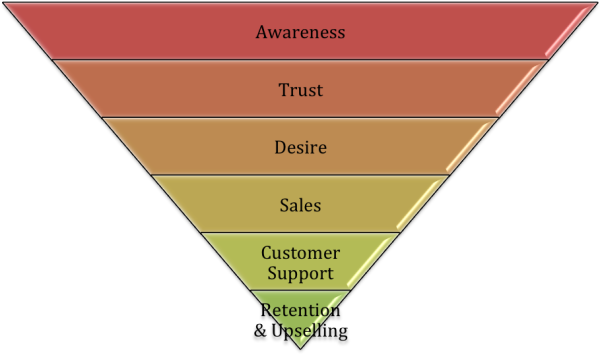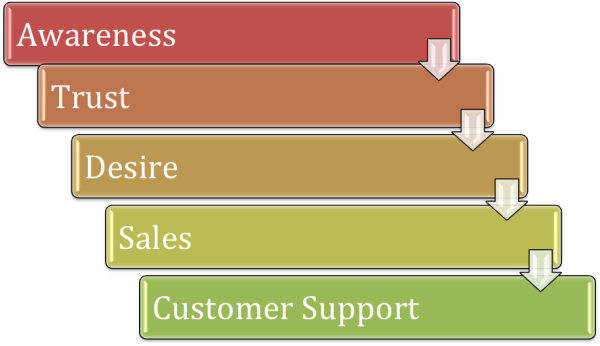
This month, I’m going to discuss content marketing strategy as it relates to search engine optimization. A lot of businesses get this wrong by focusing too tightly on the sales parts of the marketing funnel.
With PPC, Money Buys Placement
Before I get into SEO, let’s examine PPC as a contrasting approach. In paid search, you rent access to a search engine’s audience. That means, unless you’re doing a branding campaign, conversions and ROI are paramount. This makes it logical to begin with keywords possessing high searcher intent for buying. Once you get your selling keywords running on all cylinders, then you can move upward in the sales funnel and start bidding for keywords matching desire.
Max out bidding opportunities for desire, then it’s time to start buying search queries linked closely with trust. This PPC keyword selection process continues up the marketing funnel until you hit the top: awareness. The reason to start with sales and work your way up is that if you do not maximize the deeper sections of the funnel first, your only alternative is to bid on keywords with a lower ROI.
Assuming unlimited budget, there are a finite number of keywords for sale and for ways to optimize campaigns or landing pages. At some point, you’ll have to stop upping your spend or campaign higher in the marketing funnel with the intention of sending more people toward sales. This works for PPC because money buys placement.
Understanding Authority
With SEO, You Need Authority
In organic search, you cannot buy visibility with cash. Instead, the working currencies are authority and relevance. Authority comes from links and social media sharing. Here lies the catch: while you can bond money and keywords together in paid search, links and keywords possess little relationship to each other. In fact, your top converting organic keywords may also be your least link-worthy.
It’s not as easy as SEO-optimizing pages of content for your best PPC keywords. Without authority your content isn’t going to rank.
Understanding Authority
When it comes to organic search, there are two types of authority: page and domain. Page authority comes from links pointing at a document. Authority factors include:
The number of internal links pointing to a document
Document placement within a site’s web architecture
The number of offsite links pointing to a document
The number of domains linking to a document
The amount of authority possessed by each page (divided by the number of outbound links) that links to a document
Domain authority or site wide authority is an aggregate of page authority. Important factors include:
The sum of all page authority a website has
The number of pages receiving offsite links
Trends like freshness and velocity that demonstrate a website continues to receive new links and is growing in popularity
Social media links and brand mentions contribute to authority, too. Two important factors seem to be conversation volume and messenger influence, though the details of their influence are largely a mystery.
As you can see, most authority comes from outside your website. This is why link building is an important part of the SEO process.
Link Worthy Vs. High Conversion
Once you understand the importance of authority and links, you can begin thinking about link worthy content and planning your SEO optimization.
In e-commerce, an inconvenient truth is that top converting pages are often the least link worthy. Let’s pretend you sell billiards equipment and have a large catalog of balls, cues, accessories and pool tables. While it’s important that each product page to rank highly for its keywords, chances are high they will not receive many offsite links.
On the flip-side, let’s say our website has a blog full of articles and tutorials, everything from basic topics like how to shoot properly, to advanced techniques like how to size up a table before a tournament. An interesting article might earn dozens of links and hundreds of social media shares, but it’s unlikely to sell many products. You don’t want to optimize your blog articles for conversion keywords, either, because you need your sales pages to rank for them.
Or, take a software startup. Each year, there may be one or two big product releases or updates that drive high authority news media links. That’s good, but what about the other 363 days of the year? How will the startup earn the steady flow of new links and social media sharing that search engines reward?
Where conversions are highest on product pages, links will be most plentifully given to articles and resources people want to read or use, whether they ever buy your products and services or not. In the marketing funnel the greatest link-building potential lies at the top, in the awareness level.
SEO Becomes Inbound Marketing
Because you cannot only optimize catalog pages or only write amazing guides and tutorials, it’s necessary to work on your entire website’s content and promotion.
Answer these questions for each level of the marketing funnel.
What keywords fit?
What type of content will visitors expect?
What content do you want visitors to view?
Which searcher intents will visitors want to accomplish (navigational, informational, commercial investigation, transaction, entertainment)?
How will you move people deeper into the marketing funnel?
Can you promote the content? How?
Next, create a content plan for each level. Then create a capture and retention plan. For example:
Transitioning Visitors from “Awareness” To “Trust”
Attract all billiards lovers to the website with tutorials, industry news, and product news
Text articles, videos, webinars
Promote content on homepage and social media accounts
Email influential friends of the website about high value content designed to earn links
Capture names and emails by getting visitors to subscribe to the blog via email or signup for a weekly newsletter with exclusive educational content and discounts
Work your way through the entire funnel
You’ll find it more difficult to incorporate link building and offsite promotion. Don’t let that discourage you or stop you from building out SEO-optimized content. You need great content at all levels of the marketing funnel to move visitors from awareness to sales. This can include articles, guides, case studies, white papers, video and webinars, slide shows and more.
Even without their own links, pages can appear in high rankings, thanks to domain authority. As domain authority grows, pages you create and keyword-optimize may rank and earn traffic. It might take time, but when it happens, it will be worth it.
Don’t ignore customer support. A thick help section can be a generous source of organic traffic. Give customers opportunities to participate. They can ask questions to be answered on your blog, enter contests or receive exclusive content. Turn happy customers into raving fans by making it easy for them to share your links on their social media accounts.
At this point, I hope you see that you’re creating a great online marketing program first, and then optimizing it for SEO second. Keyword research may lead you to produce certain articles and pages, but while working with a strong marketing commitment, hopefully you’d have published those pages anyway.
By: Tom Schmitz
